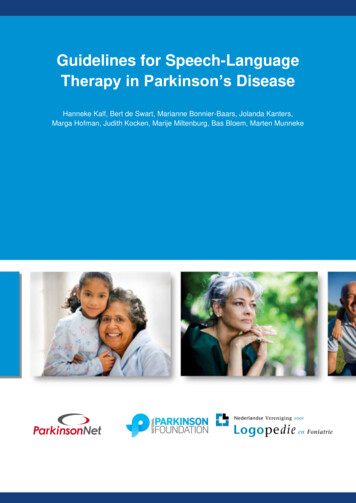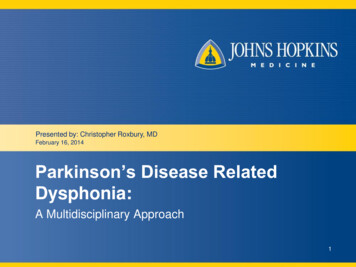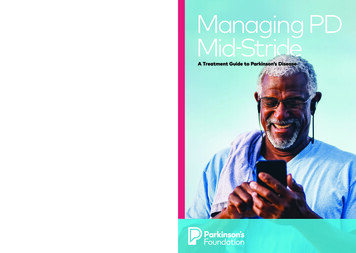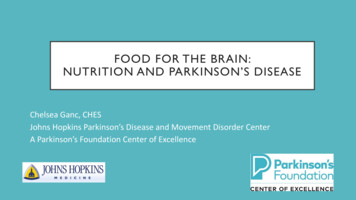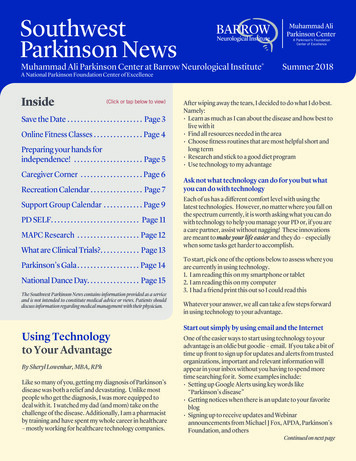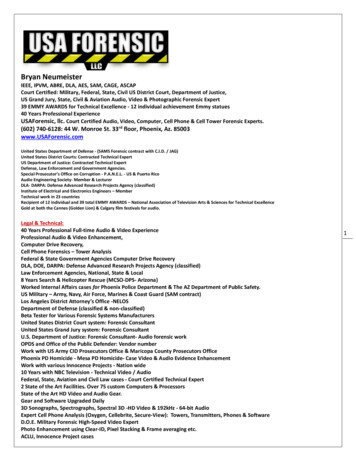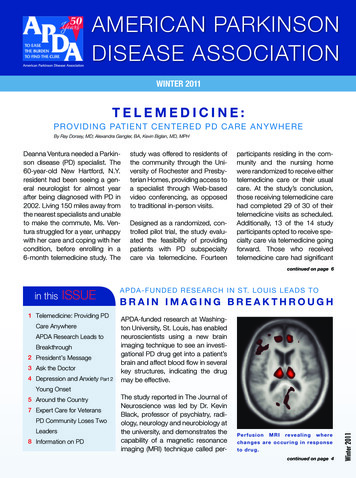
Transcription
AMERICAN PARKINSONDISEASE ASSOCIATIONWINTER 2011TELEMEDICINE:P R O VI D I N G PAT I E N T C E N TE R E D P D C A R E A N Y WH E R EBy Ray Dorsey, MD; Alexandra Gangler, BA, Kevin Biglan, MD, MPHDeanna Ventura needed a Parkinson disease (PD) specialist. The60-year-old New Hartford, N.Y.resident had been seeing a general neurologist for almost yearafter being diagnosed with PD in2002. Living 150 miles away fromthe nearest specialists and unableto make the commute, Ms. Ventura struggled for a year, unhappywith her care and coping with hercondition, before enrolling in a6-month telemedicine study. Thestudy was offered to residents ofthe community through the University of Rochester and Presbyterian Homes, providing access toa specialist through Web-basedvideo conferencing, as opposedto traditional in-person visits.Designed as a randomized, controlled pilot trial, the study evaluated the feasibility of providingpatients with PD subspecialtycare via telemedicine. FourteenWINTER 2011participants residing in the community and the nursing homewere randomized to receive eithertelemedicine care or their usualcare. At the study’s conclusion,those receiving telemedicine carehad completed 29 of 30 of theirtelemedicine visits as scheduled.Additionally, 13 of the 14 studyparticipants opted to receive specialty care via telemedicine goingforward. Those who receivedtelemedicine care had significantcontinued on page 6in thisISSUE1 Telemedicine: Providing PDCare AnywhereAPDA Research Leads toBreakthrough2 President’s Message3 Ask the Doctor4 Depression and Anxiety Part 2A P D A - F U N D E D R E S E A R C H I N S T. L O U I S L E A D S T OBRAIN IMAGING BREAKTHROUGHAPDA-funded research at Washington University, St. Louis, has enabledneuroscientists using a new brainimaging technique to see an investigational PD drug get into a patient’sbrain and affect blood flow in severalkey structures, indicating the drugmay be effective.5 Around the Country7 Expert Care for VeteransPD Community Loses TwoLeaders8 Information on PDThe study reported in The Journal ofNeuroscience was led by Dr. KevinBlack, professor of psychiatry, radiology, neurology and neurobiology atthe university, and demonstrates thecapability of a magnetic resonanceimaging (MRI) technique called per-P e rf us io n MR I re ve a ling whe rec h a ng e s a re o c c uring in re s p onset o d ru g .continued on page 4Winter 2011Young Onset
PRESIDENT'S MESSAGEDear Reader:It’s just about this time ofyear that I gird myself tostop dating checks andletters 2010. The realityof a change kicks in, andthen I will be signing 2011until next February.It makes me think about how we respond to change.No one, except the young, is supposed to like it –most resisting it until it becomes the familiar andthen fighting to preserve it. It’s normal to like whatis comfortable -- to want to keep it, but as we haveseen in the past few years, change will come. It cannot be stopped, but even unwelcome change canbenefit us.When I became APDA's president, life was good.Our budget was hovering around 11 million. Wewere funding more research than ever before, opening additional centers, offering new services. Thencame the “crash.” (In my darker moments, I think itwas waiting for me to accept the gavel.) Contributions drastically deWinter 2011creased,tradiIssue No. 93 2011tional funders cutPublished quarterly by theor stopped supAmerican Parkinsonport, postal ratesDisease Association, Inc.and other costs135 Parkinson Ave.increased almostStaten Island, N.Y. 10305800-223-2732in direct proporapda@apdaparkinson.orgtion to unately, a wiselyJoel A. Miele Sr., P.E.conservative financial plan sparedExecutive DirectorAPDA many of theJoel Gerstelhardships of someEditorsmore liberal spendMichele Popadynec, RNing and investingKathryn G. Whitfordn o n - f o r- p ro f i t s ,but times were difNational Young Onset Center25 N. Winfield Rd.ficult. Costs had toWinfield, Ill. 60190be arkinsons.org2American Parkinson Disease AssociationThere’sagoodpart to this, if you are asking. Yes, we were forcedto do more with less. We found new programs andservices we could offer that were less expensive,but equally needed and welcomed. We contractedwith Lotsa Helping Hands, an electronic programthat provides a free tool to help caregivers organizetheir volunteered help. We worked with Boston University’s Sargent College and created the first Parkinson’s rehabilitation resource including a free hotline and Web site. We entered the electronic world,which has introduced other strong venue sources.Our “Have A Question About PD?” Web site featureis providing guidance to hundreds of people aroundthe world at no cost to them and at minimal cost tous.And as with all scientific bell-curves, the slope isagain on the ascent, but lessons have been learned.We have seen true friends who continued supporting us even if it had to be at a lesser level, and foundnew ones, who recognized the value of our mission.We have a 100 percent board-giving program, andcontinue to carry out our mission of caring throughthe largest grassroots PD organization in the country.So, while we are a little harried and with a few moregrey hairs, we are thankful. Our attitude is gratitude.Have a happy and prosperous New Year.Joel A. Miele Sr., PEPresidentCharlene Allo Named Director of Chapter RelationsCharlene Allo has been appointed APDA’s directorof chapter relations. Charlene joined the associationin 1995 as executive assistant and subsequentlywas named coordinator of special events, a functionshe will continue to fill. She will be responsible forcoordinating the activities of APDA’s 46 chaptersacross the United States with the association’snational objectives and initiatives.
ASK the DOCTORMy father and uncle hadParkinson'sdisease.What are my chances of havingit also?A:About eighty-five percentof people with PD do nothave any other relative with thedisease, and consequently a family history of PD is not common.Nevertheless, a family history of PD is the strongestknown risk factor for PD. When several people inthe same family have PD, there is a stronger chancethat one of the genes that I mentioned above maybe present.In my lab, we studied about 500 families where twoor more members were affected with PD. Not oneof those families had a mutation in alpha-synuclein,and only 7 percent had a LRRK2 mutation. The Parkin gene is a bit different; one must have two copiesof the gene mutation. Usually we do not see thatform of PD showing up in two-generations. Further,the Parkin form has an unusually early onset, so themain context when Parkin testing might be in orderis for young onset PD.Q:A:Is there any new research about geneticpredisposition to PD?The understanding of the role of genetics inParkinson’s disease is progressing extremely quickly, and has advanced particularly rapidly inthe last year with the publication of eight very largegenetic studies in PD. More than 12,000 individualswith PD have now been studied using this new genetic technology to identify the genes that influencethe risk for developing PD. At least six genes havebeen clearly implicated and a similar number are verystrongly implicated and most of these will also likelyturn out to be important.The main focus of these studies is to understandwhat is causing PD, which will help us to identifyspecific biological deficits that might be targets fordeveloping newtreatments. Thiskind of researchcan take a longtime but clearlythe understanding of why peopleget heart disease(cigarette smoking, hypertension,high cholesterol,poor diet, diabetes, obesity, etc.– most of whichhave a strong ge- Richard Myers, PhD, Director, Neunetic basis) has rogenetics Laboratry, Boston University School of Medicine andbeen the main member of APDA's Scientific Advimethod to help re- sory Board.duce the frequency of heart attacks. Knowing what causes PD willunquestionably be similarly important.Q:A:Is there a test to learn if I have a Parkinson'sdisease gene?The genes implicated in Parkinson’s diseasefall into two main categories:1. Rare gene mutations with powerful effects,which can cause PD.2. Gene variants that contribute to PD riskwhen combined with other factors (eitherother genes or environmental exposures).In the first category, there are primarily three genes toconsider: 1. alpha-synuclein (also known as Park1),2. LRRK2 (Park8), and 3. Parkin (Park2). A few other very rare genetic mutations in this category areknown, DJ-1 and Pink1 for example. There are actual genetic tests for the genes in this category.The second category includes the genes MAPT (microtubule associated protein tau), GAK, (cyclin Gassociated kinase), GBA (glucocerebrosidase-betaacid), SLC41A1, and a few others. Currently, thereWinter 2011Q:continued on page 5Materials concerning Parkinson’s disease research and answers to readers’ questions are solely for information and should notbe used for treatment purposes, but for discussion with the patient’s health care provider.3
DEPRESSION AND ANXIETYTBy Annette Schrag MD, PhDhe first important issue in managingdepression and anxiety in a person withPD is to determine whether the symptomsoccur solely in off-periods. If so, adjustment ofantiparkinsonian medication is required and isusually successful.If depression or anxiety symptoms are not fromnonmotor fluctuations, the severity of symptomsshould be determined to assess the need fortreatment. In most cases with mild depression, nonpharmacological intervention is the treatment ofchoice, with treatments ranging from counseling andpatient education to cognitive-behavioral therapy.There are several medication approaches totreatment:Dopaminergic: As many patients will already be ondopaminergic medication for improvement of motorsymptoms, optimization of existing treatment may bepragmatic first step. Dopaminergic medications havebeen suggested to improve depressive symptoms inPD.than in depressed non-PD patients, although olderpatients and those with major depression may havea better response.Consideration should be given to the potential sideeffects related to these medications, particularly inthe elderly, their possible interaction with other drugsresulting in variations in plasma concentrations,reports of exacerbation of motor function and theirpotential to exacerbate nonmotor and dopaminergicdrug-related complications of the disease.There has been no systematic assessment ofanxiolytic treatment in PD. The SSRI are currentlyfavored as treatment of anxiety disorders in PD buttheir therapeutic efficacy is yet to be demonstrated.Benzodiazepines can increase the risk of falls andcognitive, autonomic and sleep-related side effectsand should be used with caution.(Part I of Dr. Schrag’s article appeared in the Fall2010 issue and can be downloaded from www.apdaparkinson.org, or ordered by calling 800-2232732.)Psychotropic: There is a suggestion thatantidepressant medications in PD are less effectiveDr. Schrag is a member of the faculty of University College’s Departmentof Clinical Neurosciences, London.APDA-FUNDED RESEARCH IN ST. LOUIS LEADS TOYOUNG ONSET PARKINSON CONFERENCEBRAIN IMAGING BREAKTHROUGHA BIG SUCCESScontinued from page 1fusion imaging to measure a drug’s effect on the dopamine system in the human brain. The drug, SYN115, can affect dopamine systems indirectly. Theperfusion MRI reveals where changes occur in thebrain in response to the new drug.Dr. Joel Perlmutter, director of the Washington University Center for Advanced Research, one of ninesuch APDA centers across the country, hailed thenew technique as an approach that can lead to newand faster ways to evaluate new drug therapies forPD.The study was funded by APDA, APDA’s St. LouisChapter, and the National Institutes of Health.4Part 2American Parkinson Disease AssociationBy Julie Sacks, LCSWDirector, APDA National Young Onset CenterThe series of Young Onset Parkinson Conferences,co-sponsored last year by APDA and the NationalParkinson’s Foundation, was a success in every respect and will continue in 2011. The regional eventsnot only provide an opportunity for learning and camaraderie, but also the live Webcasts allow peopleto participate nationally and internationally and sharein the sense of community the events foster.The next conference will be held in Des Moines,Iowa on June 18, in conjunction with the state’s annual Parkinson’s disease symposium.SAVE THE DATEYOUNG ONSET PARKINSON CONFERENCEDes Moines, Iowa June 17-18, 2011
AROUNDU n i t y Wa l k t o H o n o rChapter MemberTHEArizonaCongratulations to Jean Burns, who will receive theAlan Bonander Humanitarian Award at this year’sUnity Walk, April 16, in Central Park, N.Y. Jean hasbeen an active member of APDA’s Arizona chapterand was honored as its 2006 distinguished volunteer. She is also the 2009 recipient of the Parkinson’sAction Network’s Milly Kondracke Award.S h o r t y Tu r n s 4 0 i n S a n F r a n c i s c oThere aren’t manywomenwho’llannounce aginganother decade,but that’s exactly what Kathryn Collier, sisterof New JerseyChapterpresiFrom Kathryn Collier’s “Shortydent, Vicki ColTurns Forty” Web site camlier, did on Dec,paign.30, and launcheda year-long fundraiser/awareness campaign with allproceeds to support APDA’s research program. Todate, Kathryn’s aging has contributed 17,000 viawww.shortyturnsforty.org.South Florida Raises the Bar forR e s e a rc hCOUNTRYgolf, showed fashions, sailed, rocked, and evenraced gerbils, but only the South Florida Chapterhas horsed around to support research and awareness. Designed by young equestrian Hannah RachelBentz, as her mitzvah project, Jump for a Cause,brought more than 200 people to the Jim BrandonEquestrian Center in West Palm Beach, where BobbiRottman’s team, Buttonwood Street, took top kudos. Hannah dedicated the project to Rabbi MerleSinger, who was diagnosed with PD shortly after hisretirement. And good followed good. Less than aweek later, Michael Perez, director of the spa at theFour Seasons Resort, Palm Beach, conducted a silent auction in honor of Hanna, adding nicely to theevent’s success.Going Latin in WisconsinThe benefit of dance has been well established, includingAPDA-funded research that launched the Argentine Tango as a rehabilitation aid. In Wisconsin it is Zumba Gold,a version of the popular Zumba, a Latin-inspired workout.APDA’s Wisconsin Chapter sponsors weekly free classesat the Harbor Athletic Club, Middleton.ASK the DOCTORcontinued from page 3are not genetic tests for this category of genes, anda lot more work to identify what goes wrong in thesegenes will need to be done for them.APDA chapters have walked, danced, dined, playedDr. Richard Myers is a PhD medical geneticist and professor of neurology at Boston University. He has been a member of the APDA ScientificAdvisory Board since 1996. His laboratory has been studying the geneticsof PD for almost 20 years.Winter 2011Hannah Bentz rides Crystal during Jump for a Cause.5
TELEMEDICINECAN MAKE A DIFFERENCEcontinued from page 1improvements in their quality of life and in their symptoms compared to those who received usual care.Ms. Ventura stated, “I truly feel that I got the type ofattention that I needed and was not accessible to mebecause of the area I lived.” The study, which wasrecently published in Movement Disorders, showedthat providing subspecialty care remotely is, in fact,very feasible.T h e G ro w i n g P D B u rd e nParkinson’s disease is a chronic condition with a burden growing both in the United States and globally.Studies have shown that people live for an averageof 14 years, or roughly one fifth of their lives, with thedisease, and that 40 percent of these individuals willrequire nursing home care at some point in time.In 2005, studies estimated that there were 4 millionpeople in the world’s most populous countries withPD. By 2030, this number will more than double. PDis readily treatable with affordable medications thatsignificantly decrease risk of death, the vast majority of those affected by the disease globally has notsought or received treatment.Another major challenge, as demonstrated by Ms.Ventura’s case, is that access to a specialist is currently very limited. As with any chronic condition,increased access to specialists can improve patientcare and outcomes, and ultimately lead to a betterquality of life. In a study of 300 individuals with PDacross the United States, those who saw a specialistwere three times more likely to be satisfied with theircare than those who saw a general neurologist.Te l e m e d i c i n e : H o w i t Wo r k s a n d H o w i tCan HelpWith so many hurdles that accompany this burdensome condition, it begs the question: is there a wayto provide high-quality, patient-centered care to individuals with PD regardless of their location? The answer is yes. Through simple Web-based video conferencing, telemedicine visits can extend the reach ofcare into the home. A readily available, feasible and6American Parkinson Disease Associationinexpensive solution, a “virtual house call” requiresnothing more than a computer with broadband Internet access to provide care to anyone anywhere.Most visits that have been carried out through studies have used a simple set-up such as Skype withencryption, the same technology grandparents useto talk to their grandchildren every day.Furthermore, telemedicine can be the solution toseveral issues surrounding rising health care costs.The current model for receiving care requires patients to travel miles and, in most cases, probablypay more for transportation costs than for the actualvisit. These in-person visits are an enormous loss oflabor, time and productivity for both the patients andcaregivers. Proponents say that telemedicine technology can increase cost efficiency, reduce transportation expenses, improve patient access to specialists, and ultimately improve the quality of care andthe quality of life for patients with chronic conditionslike PD.G o i n g F o r w a rd , W h a t Yo u C a n D oDespite its value, Medicare and other healthcare insurers currently do not cover most telemedicine services for 80 percent of people who could benefit. Tobring about change, in hopes of providing patientcentered care to people with PD anywhere they live,advocates are urging more awarness. Some of theprominent issues that must be overcome before implementing the telemedicine model include: Obtaining insurance reimbursement for telemed icine visits at both the state and federal levelExpanding geographical coverage for reimburse ment to all communities and to your homeAddressing state licensure barriers for physiciansProposed legislation includes the Medicare Telehealth Enhancement Act of 2009 (H.R.2068). Onesource is the American Telemedicine Association atwww.americantelemed.org.The author can be contacted via e-mail: Dr. Dorsey at PDMDfeedback@jhmi.edu or Dr. Biglan at Nicholas Scoglio@URMC.Rochester.edu.
V E T E R A N S A F FA I R S PA D R E C C C E N T E R SPROVIDE VETERANS WITH EXPERT CAREBy Rebecca Martine, MSN, RN, PMHCNSTwo years later the PADRECCsintroduced the National VA Parkinson’sDisease Consortium in an effort to promotePD awareness throughout the VA. This initiativefocuses on professional networking, mentorship,and training. The consortium is composed ofmore than 225 members including VA physicians,nurses, pharmacists, social workers, physicalPD COMMUNITYTwo of APDA’s mostselfless champions for theParkinson’s community havesuccumbed to complicationsfrom the disease.Jim Mauer, diagnosed in1990 and founding presidentof APDA’s MassachusettsChapter, became a giantJim Mauerincreatingawarenessacross New England. Announcing his death, CathiThomas, APDA’s Boston Information & ReferralCenter coordinator, said, “Jim was able to utilize hispersonal charisma, his keen marketing sense, andhis unending commitment to Parkinson’s to networkwith the medical, research, and patient-advocatecommunities. He always had time to make a positiveand occupational therpists and other allied healthprofessional.To broaden the impact of its mission, PADRECClaunched the Consortium Center Network in 2006.,a network of 51 designated PD clinics acrossthe country providing veterans convenientaccess to specialty care. Centers' staffinclude movement disorder specialistsand other neurologic healthcareproviders.All veterans enrolled in the VA HealthcareSystem are eligible for PADRECC orConsortium Center services. Additionalinformation including locations of centersand how to make an appointment is available atwww.parkinsons.va.gov. or by calling 800-949-1001ext. 2749.Ms. Martine is chairperson of the National VA PD Consortium, andassociate director of education at the Philadelphia PADRECC.LOSES TWO LEADERSdifference in someone’s life.” Jim was 78 years oldand survived by his wife Vicki, and children James,John, and Mollie Sorenson.Margaret Miller was a volunteer leader in theAtlanta, Ga. public school system when she wasdiagnosed in 1994. She then turned her effortshead-on and full-steam-ahead, totally involved anddetermined to “fight back” against the devastatingdisease. Margaret became heavily involved infundraising for research and served on APDA’sGeorgia Chapter’s executive board for 10 years. ”Herpositive attitude and smile touched so many friends –not only in the Parkinson’s community but everyonewith whom she came in contact,” remembers KathyEdwards, chapter director. She leaves her husbandCarl and three daughters, Cameron Tiedje, Robin,and Courtney Sanders. She was 74 years old.SummerWinter 20112010When the Department of Veterans Affairs (VA)launched its Parkinson’s Disease Research,Education and Clinical Centers (PADRECC) inPhiladelphia, Richmond, Houston, West Los Angeles,San Francisco and Portland/Seattle in 2001, 80,000veterans with Parkinson’s disease were givena way to manage their care better. ThePADRECCs provide a system for directaccess to pharmacy benefits; physical,occupational, and speech therapies;medical equipment; surgical servicesand other valuable resources.7
INFORMATION ONE D U C AT I O N A L M AT E R I A LPARKINSON’S DISEASEA N D PAT I E N T S U P P O RT R E S O U R C E SAPDA is the source of a variety of free educational and patient/caregiversupport materials. Most publications listed below can be downloadedfrom the Web site, www.apdaparkinson.org, publications page. Singlecopies are available by writing to the national office or calling 800-2232732, faxing to 718-981-4399, or contacting any of the APDA Information& Referral Centers throughout the United States.Free subscription to a monthly e-newsletter and “Tip of the Month”feature are available on APDA’s Web site home page. Lotsa HelpingHands, a private, caregiving coordination service that allows family,friends, neighbors and colleagues to create an online community to assista caregiver with daily tasks can be reached by clicking the “Ease theBurden” button.APDA’s National Resource Center for Rehabilitation provides directtelephone (888-606-1688) and email (rehab@bu.edu) access to a licensedphysical therapist at Boston University’s College of Health and RehabilitationSciences: Sargent College, to answer questions about exercise, provideinformation about programs in the caller’s area and provide educationalmaterials.BOOKLETS(order by letter)A. Parkinson’s Disease HandbookB. Young Parkinson’s HandbookC. Be ActiveD. Be Independent*E. Speaking EffectivelyF.Good NutritionG. Aquatic Exercise for Parkinson’sDiseaseH. My Mommy Has PD But It’sOkay!SUPPLEMENTS(order by number)4. Keys to Caregiving5. Hospitalization of a Parkinson’sPatient6. The Living Will and DurablePower of Attorney for HealthCare7. Parkinson’s Disease and OralHealthFLYERS8. The Family Unit and Parkinson’s9. Maintaining Independence10. The Challenge of Parkinson’sDisease: Adapting to a NursingHome13. Medical Management of Parkinson’s Disease and MedicationsApproved for Use in the USA16. When Should Parkinson’s DiseasePatients Go to the EmergencyRoom?17. Neuro-ophthalmology and PD20. Fatigue in Parkinson’s21. Dr. Andrew Weil’s Recommendations for Healthy Aging22. Depression and Parkinson’s23. Incontinence and Parkinson’s24. Employment and Parkinson’s25. Constipation and Parkinson’s Basic Information aboutParkinson’s Disease National Young Onset Center Medications to Be Avoidedor Used with Caution in PD 34 Helpful Hints to Improvethe Quality of Life of Peoplewith Parkinson’s The Importance of Havinga WillWEB SITES www.apdaparkinson.org www.youngparkinsons.orgDVD Managing Parkinson’s:Straight Talk and HonestHope, Second Edition*Available by downloading from www.apdaparkinson.orgThe printing and distribution of this newsletter are supported by a grant from Novartis
munity and the nursing home were randomized to receive either telemedicine care or their usual care. At the study's conclusion, those receiving telemedicine care had completed 29 of 30 of their telemedicine visits as scheduled. Additionally, 13 of the 14 study participants opted to receive spe-cialty care via telemedicine going forward.
